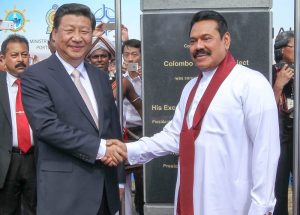By Dr. James M. Dorsey
EXECUTIVE SUMMARY: The pending Chinese acquisition of a stake in Tajikistan’s aluminum smelter, coupled with earlier tax concessions to Chinese companies that would substantially reduce the trickle down effect of investments for the troubled Tajik economy, suggest that China has yet to fully take into account frequent criticism of its commercial approach to Belt and Road-related projects.
Desperate for cash, Tajikistan is about to sell yet another vital asset to China at a time when countries like Sri Lanka and the Maldives are demanding renegotiation of debt settlements that either forced them to surrender control of critical infrastructure or left them with unsustainable repayments.
The Washington-based Center for Global Development warned last year that “23 of 68 countries benefiting from Belt and Road (BRI) investments were significantly or highly vulnerable to debt distress.”
The center said eight countries — Tajikistan, the Maldives, Pakistan, Djibouti, Kyrgyzstan, Laos, Mongolia, and Montenegro — are particularly at risk.
“There is…concern that debt problems will create an unfavorable degree of dependency on China as a creditor. Increasing debt, and China’s role in managing bilateral debt problems, has already exacerbated internal and bilateral tensions in some BRI countries,” the report said.
Progress on the construction of a road in Afghanistan’s Wakhan Corridor, a narrow strip in the east of the country that touches the Chinese border and separates Tajikistan from Pakistan and Pakistan-controlled Kashmir, may explain China’s seeming insensitivity to the concerns of beneficiaries of the People’s Republic’s largesse.
The road would link the corridor to Central Asia in the north and Pakistan’s Chinese-built Arabian Sea port of Gwadar in the south, a crown jewel in China’s infrastructure- and energy-driven Belt and Road Initiative.
To be sure, the road has local rather than geopolitical significance for the workers building it (it provides them with jobs), as well as for the region’s shepherds (it facilitates access to mountain pastures), as documented by anthropologists Tobias Marschall and Till Mostowlansky.
For China, the stakes are geopolitical and economic.
The road would not only facilitate commerce with Central Asia as well as traffic from Gwadar but also construction of shorter pipelines as well as a fiber optic cable.
Perhaps more importantly, it would, together with a military base in Tajikistan and Chinese cross border operations in the corridor itself, facilitate the movement of troops in China’s gradual projection of military power beyond its borders, particularly in regions adjacent to its troubled northwestern province of Xinjiang.
The road’s potential military significance raises questions about the sustainability of a presumed division of labor between Russia and China under which Russia shoulders responsibility for security in Central Asia while China concentrates on economic development.
Ironically, if the examples of Sri Lanka, the Maldives, Pakistan, and Malaysia are anything to go by, coupled with anti-Chinese sentiment in Central Asia fueled in part by the brutal crackdown on Turkic Muslims in Xinjiang, China’s approach to Belt and Road-related development could turn out to be a threat to its broader geopolitical ambitions and regional security policy.
Sri Lanka recently demanded that China return control of Hambantota port.
Sri Lanka became the poster child of allegations that China was pursuing debt trap diplomacy two years ago when it surrendered control of the port to China as part of a deal to reduce the country’s debt payments.
China lent Sri Lanka $5 billion between 2010 and 2015 for infrastructure projects that included development of Hambantota at interest rates of up to 6.3%.
By comparison, World Bank and Asian Development Bank rates on soft loans range from 0.25% to 3%.
“The perfect circumstance is a return to the norm. We pay back the loan in due course in the way that we had originally agreed without any disturbance at all,” said newly appointed Sri Lankan PM Ajith Nivard Cabraal.
Similarly, the foreign ministry of the Maldives said earlier this month that it is seeking to restructure its Chinese debt.
“Borrowings by the previous government were unreasonable and put us in difficulty. But we can solve this mess through diplomatic means,” said FM Abdulla Shahid.
Last month, former president Abdulla Yameen was jailed for five years and fined $5 million for corruption during his term, which ended late last year. Shahid’s government has accused China of land grabs during Yameen’s term.
In a rare success, Malaysia earlier this year negotiated a one-third reduction in the cost of a $15.7 billion Belt and Road-related rail project. In a further concession, China agreed that 70% of the workforce would be Malaysian and that Malaysian contractors would get 40% of the civil works.
China has been accused repeatedly of employing Chinese rather than local labor for Chinese-funded projects along the Belt and Road and importing materials from China rather than sourcing them locally.
The government of Pakistani PM Imran Khan has been less successful than its Malaysian counterpart.
It recently bowed to Chinese pressure to revive hundreds of projects that were suspended after the government took power in 2018.
The appointment of a retired lieutenant general as head of a new authority overseeing the China Pakistan Economic Corridor (CPEC), which groups together Belt and Road-related projects, reflected China’s wariness toward messy Pakistani politics and preference for dealing with the country’s military.
With Sri Lanka as the antithesis, analysts suggest that China is determined to make Pakistan a success story.
“The big battle at the moment is about CPEC’s reputation, and Beijing cares about salvaging that. They need to show BRI has been a success, that it hasn’t put Pakistan’s economy in trouble and that there isn’t a backlash. If they can’t do it in a context like this, it suggests that there is something flawed in the model,” said Pakistan and China scholar Andrew Small.

No comments:
Post a Comment